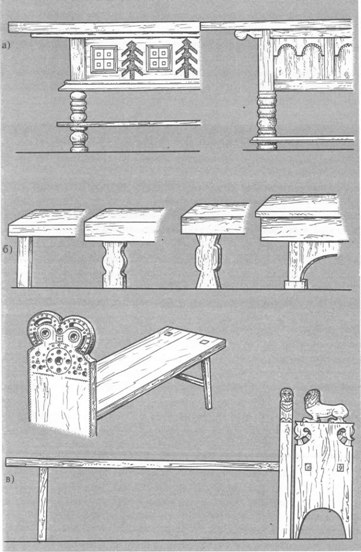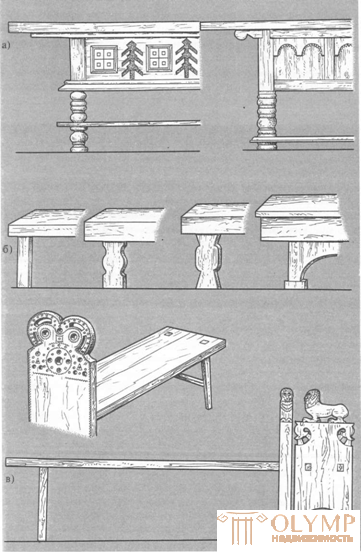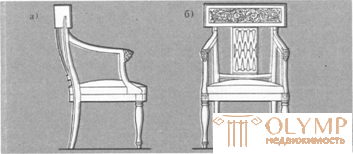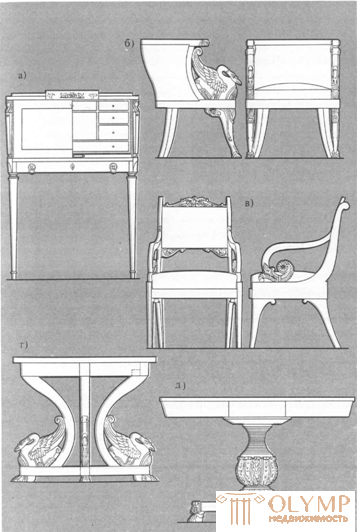
The furniture industry had a great influence on the development of furniture business in Russia (Fig. 1). In the peasant life used tables of different sizes, benches, supplies (kitchen tables). The dining table in the hut stood in the red 'corner (right of the entrance) and was the center of the composition of the entire room. The tables were made quite large with a rectangular cover with a ratio of 1: 2 and 1: 1.5. For the covers chose the best quality boards, carefully processed.
The underframe was carried out in various versions: plank sidewalls with a notch below, connected by a lead, and legs, connected by two leads or a circle; without a king and with a king; with one or two drawers; in simple carpentry or threaded turning.
The supplier - the kitchen table was intended for cooking and therefore was above the dinner table and supplied with a deaf underframe with one or two drawers and shelves behind the doors.
Benches (benches) were an obligatory accessory of a peasant hut and were placed either along the entire length of the walls from two or even from three sides, or only in a part of the walls within the red corner. The board of the seat was fastened tightly along the entire length in the groove between the logs of the wall and rested on the wedges lying also in the groove, and from the front side rested on the figured legs cut from the board or turning.
A special product of Russian folk furniture was the peremetny benches, the back of which could be thrown from one side of the seat to the other without turning the benches. Placed against the wall of the bench could serve as a safe place to sleep a child.
The national features of Russian life and art had a significant influence on the character of the interior decoration of the homes of the boyars and kings. The stone and wooden chambers of the Russian princes were cleaned in about the same traditions as the original Russian hut, where all the furnishings, except for the table, were cut into the walls. Along the walls of the hut were wide benches with carved edges, in the red corner was placed the goddess, in front of her table.
In the 17th century, the international relations of the Moscow State expanded, which could not affect the nature of the furniture decision. In imperial use, armchairs and chairs with high carved backs, upholstered in cloth or velvet, began to appear in a small number; caskets decorated with mother of pearl and a turtle, Venetian mirrors, etc.

Fig. 1. Russian folk furniture: a - table supports; b - bench supports; in - bench
The furnishings were not only imported, they were created in the Armory, where woodcutters and gilders worked — masters Semyon Darevsky, Klim Mikhailov, Gerasim Okulov and others serving the Moscow palaces.
Russian furniture of the seventeenth century is not much known. The armchairs in some monasteries retained especially ancient traditional forms. They are simple and straightforward, their back and elbows made of thin panels are decorated with either a slit geometric ornament or a recessed thread of ribbon weave.
In the first quarter of the XVIII century, foreign furniture masters appear. Together with the invitation of Western craftsmen and the purchase of furniture abroad, domestic production developed. Russian art, accepting and processing foreign samples, went along an independent path. “Used furniture, as in everything else, Russia, including in the general flow of European development, brought a fresh stream of its originality into it, gave a number of new solutions unfamiliar to the West. In Russian furniture there was a kind of selection and development of the most vital in foreign furniture ”.
Oak tables on massive turned legs with spherical thickenings connected by broad guts are typical for this epoch. The underframes had drawers with strongly profiled frames, decorated with carved stars or a complex decorative motif, echoing the shapes of the Moscow architecture. The table top with side boards sliding out from under it resembled Dutch patterns. Tables are often painted with green paint.
The main direction of development of the Russian furniture business was the closest connection with architecture. In the 40-50s of the 18th century, V. V. Rastrelli and S. I. Chevakinsky, creating a number of Palaces and houses of nobility, whose interior decoration was distinguished by magnificence, had a noticeable influence on the development of furniture art.

Fig. 2. Chair mahogany (end of XVIII century): a - front facade; b - side facade
In the second half of the 18th century, when such architects as V.I. Bazhenov, Ch. Cameron, J. Quarenghi, MF Kazakov, I. Ye. Staroy worked, the picture changed significantly. A classic trend is developing. For the court and the nobility, for the decoration of numerous palaces and houses of St. Petersburg and Moscow, furniture production is developing, which has attained a high artistic level at this time. “The furniture of Russian classicism is not imitative art, on the contrary, with full mastery of European techniques, it has its own distinctive features.”
The transition from the curved forms of Baroque and Rococo to the calm, straightforward designs of classicism in Russia is completed by about the eighties of the 18th century (Fig. 2). At the same time, classical ornamentation is mainly affirmed, in which echoes of Baroque appear and independent decorative solutions develop, proceeding from the folk ornament (openwork carving in the form of rosettes, rhombuses, etc.). The originality of color combinations is preserved. At the end of the century, Russian masters introduced a new effective material - Karelian birch, distinguished by the beauty of its golden tone and pattern of a layer with dark “eyes”.
In addition to wood, bone is sometimes used as a material, metal is also used, and burning is often used. The most common ornament is a geometric net or star, as well as an ornament depicting vases, garlands and flowers.
The original examples of Russian classicism of the 18th century are the interiors of the Sheremetev palace near Moscow in Ostankino. Almost all the carved gilded furniture was made by the hands of Russian masters (Gavrila Nemtsov, Yakov Dunayev, carver Ivan Semenovich Mochalin, Fyodor Ivanovich Prya-hin).
Metal furniture made by the masters of the Tula Arms Factory of steel and bronze was unique.
In the eighties and nineties of the XVIII century Tula master artists create furniture in a classic style. This toilet tables, chairs, round tables, screens, benches. Nothing like furniture is found in other European countries. Metal allows to achieve refinement of forms inaccessible to wood. The slimness and lightness of thin legs and frames create the impression of airiness. Things seem showered with jewels, so they are perceived as works of jewelry.
Russian furniture of the end of the XVIII - beginning of the XIX centuries is closely connected with the work of architects A. N. Voronikhin, A. D. Zakharov, M. f. Kazakova, J. Quarenghi, Toma de Thomon, K. I. Ros-si, V. B. Stasova, I. O. Beauvais. Most of the major architects of this period when creating interiors designed and furniture. In the first half of the XIX century, special workshops are also engaged in the manufacture of furniture, the largest of which was the workshop of G. Gambs, a student of D. Roentgen. In St. Petersburg such masters work as Grosse, V. Bobkov, A. Tur; in Moscow - the workshops of AK K. Pick.
A brilliant page in the history of Russian interior was the work of A. N. Voronikhin (1759–1814), whose furniture was distinguished by its harmony and exquisite proportions. He did not use bronze ornaments; carvings and decorations were made of wood, gilded or covered in black and green tone under the old bronze. Voronikhin worked on the interiors of the Pavlovsk Palace, he owned magnificent interiors of the pink pavilion in Pavlovsk, etc. Voronikhin created armchairs and sofas with carved openwork backs in the Greek hall of the Pavlovsk Palace, and he decided to design eagle-shaped eaves in his ornament. The chairs of the boudoir of the palace of this great master are distinguished by their grandness. For the halls of peace and war, Voronikhin used curved chairs on lion legs. Furniture, designed by Voronikhin for residential premises, is distinguished by its chamber character. It has lighter forms, bright and cheerful tones. For example, in the setting of the Pink Pavilion, Voronikhin used a wavy birch, whose golden hue is underlined by inlays of black wood, applied with great restraint. He gave much attention to the upholstery of furniture, for which he created sketches of woolen embroidery with a cross.
In the 19th century, Russian Empire style furniture was increasingly developed (Fig. 3); especially varied seating furniture. Carved figures of swans, eagles, lions are often introduced into the elbows of chairs, similar motifs are used for carved backs of chairs. Along with them are widely used forms, devoid of ornaments. Spread smoothly curved backrests lined with mahogany or Karelian birch. The increasing role in the interiors of the noble houses begin to play sofas, there is even a special room - the sofa. At the beginning of the century, sofas make a rectangular shape, of considerable size. Then there are sofas in the form of a boat. A sofa is widespread, in which the sides are shaped in the form of carvings of lions, swans, sphinxes. The smooth surfaces of the backs and elbows are covered with plywood from Karelian birch and mahogany.

Fig. 3. Examples of Russian furniture of the beginning of the XIX century: a - the secretary of mahogany; b - chair of Karelian birch; in - mahogany chair; g - table of Karelian birch; d - mahogany table
Furniture Rossi is characterized by solemnity and pomp. He mainly uses the vegetative ornamentation of antiquity (palmettes, wreaths, acanthus leaves). Rossi preferred certain color combinations: white with yellow or orange, white with blue or blue. Occasionally applied a pale lilac or pale green gamma.
In the middle of the XIX century, in connection with the growth of furniture production, specialized stores opened, which gradually replaced sales of products directly in the workshops. In the shops they sold not only finished, but also “white” products, i.e. without finishing, as well as parts. Buyers could order the finish to your liking, call the upholsterer to the house, etc.
From the middle of the 19th century, the science of furniture also began to develop, for the first time, specialists (doctors and hygienists) find out the influence of the function of furniture on its size, determine the curved back of the furniture for sitting, the main dimensions of other furniture products. In the same period, stylistic changes occur in Russian furniture. In the 1930s, the heaviness and monumentalism of the Empire style was smoothed out. Furniture becomes easier and more intimate. The art of the East is coming into fashion, more and more soft pieces of furniture are upholstered in carpets. Furniture sets in terms of composition and size are increasingly adapting to the size of apartments. Buffets, sideboards appear.
A characteristic feature of the middle of the XIX century is the distribution of furniture in the Biedermeier style, the essence of which was the repetition of palace furniture products of the XIX century with a decrease in their size and ease of form. The thread was made in the same material as the object itself. For cladding preferred rosewood, dark walnut, ebony and their imitation. Some products are encrusted with metal and tortoise. The upholstery becomes brighter: colored silk, striped chintz with bouquets, wool with embroidery, velvet, plush, leather.
In the 1950s, an artistic crisis grew, which led to eclecticism by the end of the 19th century. Furniture products lose their style, purity, they mix the features of all previous periods.
Analysis of the development of Russian furniture allows to note its characteristic features:
- close connection of the artistic solution of products of folk peasant furniture with its functional purpose (table-setter, curved benches, etc.), wide distribution of built-in structures fixed at the place;
- a significant impact on the development of furniture art of folk furniture; - close connection of furniture art with Russian architecture and a major contribution of architects to the development of furniture in Russia (works of Rastrelli, Voronikhin, Rossi, Stasov, etc.);
- the creative contribution of Russian furniture makers to the overall development of furniture art (new design solutions, the introduction of new materials: Karelian birch, metal, etc.);
- high culture of wood processing;
- cheerfulness, beauty, pattern, especially vividly manifested in the early stages of the development of Russian furniture.
Что бы оставить комментарий войдите
Комментарии (0)